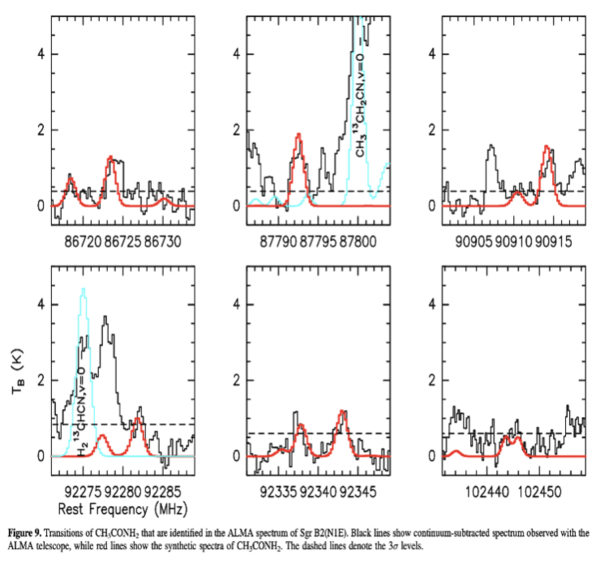Propionamide (C2H5CONH2): The Largest Peptide-like Molecule in Space
Proteins, as the building blocks of living cells, are an essential component of living systems on Earth. Proteins are polymers of amino acids joined together by the peptide bond, -NHCO-. Due to the high molecular weight and extremely low gas-phase abundance, detection of proteins in the interstellar medium (ISM) at the current stage of development of observation facilities looks like a formidable task. Therefore, molecules with peptide-like bonds are of particular interest for our understanding of possible routes of protein formation in space. The number of peptide-like molecules found so far in space is quite limited. The simplest molecule containing a peptide- like bond, formamide (NH2CHO), was detected in Sagittarius B2 (Sgr B2) in the 1970s. About 30 years later, its homologue (homologue means molecules that have the same functional group -NHCO-, but with additional methyl group, CH3-), acetamide (CH3CONH2), was detected in Sgr B2(N). N-methylformamide (CH3NHCHO) and urea (NH2C(O)NH2) were also identified in Sgr B2(N). Recently, a number of the amide molecules, including NH2CHO, CH3CONH2, and CH3NHCHO, were detected in massive cores NGC 6334I. These observations suggest that peptide-like molecules might be widespread in space.
Propionamide (C2H5CONH2), a complex alkyl amide with 12 atoms is the next member of the amide chemical family after formamide and acetamide. The new laboratory measurements of the propionamide spectrum were carried out in the 9–461GHz range, providing a good opportunity to check directly for the transition frequencies of detected interstellar lines of propionamide. Using these new analyses, based on the six clean lines of propionamide toward Sgr B2(N1E), which are consistent with the LTE synthetic spectrum of propionamide, we reported the tentative detection of propionamide in Sgr B2.
The detection of propionamide in Sgr B2(N) demonstrates that interstellar chemistry can reach sufficient levels of complexity to form relatively large peptide molecules and shows the possible growth of larger amide molecules from smaller ones in a massive star-forming process.

Li, J.; Wang, J.; Lu, X.; Ilyushin, V.; Motiyenko, R. A.; Gou, Qian; Alekseev, E. A.; Quan, D.; Margules, L.; Gao, F.; Lovas, F. J.; Wu, Y.; Bergin, E.; Li, S.; Shen, Z.; Du, F.; Li, M.; Zheng, S.; Zheng, X. "Propionamide (C2H5CONH2): The Largest Peptide-like Molecule in Space”. The Astrophysical J. 919, 4 (2021) 10.3847/1538-4357/ac091c (IF: 4.9)
